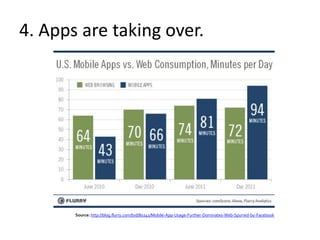Connecting for Change: 5 Reasons Why Nonprofits Should Care About the Semantic Web
- 1. connecting for change: 5 reasons why nonprofits should care about the Semantic Web
- 2. so… what is the Semantic Web? …no code (I promise)
- 3. { a historical view }
- 4. 2001 / 2013? 1999 / 2004 Web 3.0 Semantic Web Web 2.0 TBD 1994 / Social Web 1998 Facebook, Twitter, Wikipedia, … 1991 / Web 1.5 1994 Search Web Google Web 1.0 Static Web Yahoo
- 6. the Semantic Web is a way of making websites readable by machines to improve discovery, sharing, and interconnection
- 7. so… why should you care?
- 8. 1. Google cares. 2. Facebook cares. 3. Open data is here. 4. Apps are taking over. 5. Connections may be your most valuable resource.
- 11. 2. Facebook cares. Source: https://developers.facebook.com/docs/opengraph/ Source: http://www.zdnet.com/photos/ screenshots-the-facebook-timeline-and-the-open-graph/
- 12. 3. Open data is here. WordNet OpenCalais GeoNames DBpedia Freebase CIA World Factbook data.gov data.gov.uk US Census NASA and more…
- 13. Source: Linked Open Data cloud as of 2011, http://en.wikipedia.org/wiki/Open_Data
- 14. 4. Apps are taking over. Source: http://blog.flurry.com/bid/80241/Mobile-App-Usage-Further-Dominates-Web-Spurred-by-Facebook
- 15. art of the API Hello. my app Hello. your app
- 16. 5. Connections may be your most valuable resource. funders donors partners volunteers your org people you serve volunteer opportunities & jobs
- 20. in conclusion… • the Semantic Web helps people find you • the Semantic Web helps people ask the right questions • the Semantic Web helps people remix data for good
Editor's Notes
- #5: Background material (not to be read aloud):===========================4 web paradigms: oversimplificationEach paradigm has a period of incubation and a period of dominance. However first two coexist as strategies, as do second two. Web 3.0 still in its infancy – though proposed a long time ago now.Each paradigm is illustrated by a dominant company/organization, and has a distinctive strategy by which it helps manage the growth of the Web (complexity) while maintaining quality/relevance.Web 1.0:1991 – Tim Berners-Lee makes a Web page publicly available on CERN site (were precursors, but nothing accessible to general public)1994 – Yahoo is foundedStrategy: Directory of pagesFlaws: Requires humans to update directory, implies universal hierarchyWeb 1.5:1994 – Webcrawler: search engines begin, but co-exist as a discovery mechanism1998 – Google is foundedStrategy: Have search engine crawl WebInitial flaw: How to determine relevance off keywords aloneGoogle’s solution: PageRank – leverage people’s linking behaviors to determine relevanceFlaw: “Black hat” SEO – people game the systemWeb 2.0 – “read/write Web”:1999 – Web 2.0 term is coined by Tim O’Reilly2004 – Facebook is foundedStrategy: Make it easy for people to create and share Web content, so existing good content will rise to the top, and people can collaborate on new distributed projects that would’ve been impossible previouslyFlaws: Conversation can be captured within particular sites – “walled garden” effect as in pre-WWW online service era; problem of credit for individual people’s work – sometimes “hive mind” effect is createdWeb 3.02001 – Tim Berners-Lee writes original article proposing it in Scientific AmericanStill to be realized in full formStrategy: Structured description of Web documents, for machines to classify; machine learning & semantic classification – build a “question engine”, not just a search engineResponds to external threat from “walled garden” effect of apps, as well as internal threat seen by flaws in previous strategiesFlaws: Difficult to actually implement – manual intervention to apply semantic markup to documents; standards confusion & politics
- #10: Google is starting to use “rich site snippets” to enhance search results. See examples on this slide. There are different ways to create them, but Google provides a how-to section on their web site. You can use Google Webmaster Tools to confirm they are coming across correctly.Background notes:Google’s rich site snippets tool can generate its information via multiple means: microformats, RDFa, microdata (basically in that order of preference).Microformats – use class & relRDFa – based on XHTMLMicrodata – uses new properties added to HTML in the HTML5 standardSchema.org is a particular “ontology”: i.e., way of describing things in the world which is used with microdata. Can also be used with RDFa. Supersedes the microformat standards, since there were so many of them.Further reference:Google’s announcement: http://googlewebmastercentral.blogspot.com/2009/05/introducing-rich-snippets.htmlExplanation of three types - http://spyrestudios.com/real-world-microformats-rdfa-microformats-and-microdata-practical-examples/More on microformats - http://sixrevisions.com/web-development/ultimate-guide-to-microformats-reference-and-examples/More on RDFa - http://rdfa.info/More on microdata - http://www.webmonkey.com/2010/09/microdata-html5s-best-kept-secret/Schema.org types - http://schema.org/docs/schemas.html
- #11: Google has taken it a step further with Semantic Search. Remember Wolfram Alpha? This is Google’s attempt at that sort of approach.Link: http://dejanseo.com.au/google-semantic-search/
- #12: More info for non-techies: http://blog.programmableweb.com/2012/04/11/facebook-to-expand-social-graph-api-to-include-places/Examples: http://allthingsd.com/20120118/the-most-interesting-uses-of-facebooks-new-open-graph/Going beyond the “like”: http://www.yvoschaap.com/weblog/facebook_open_graph_going_beyond_the_likeHow to, for developers:https://developers.facebook.com/docs/opengraph/
- #13: Open Data is about governments, academic institutions, nonprofits, consortia, etc. making large datasets available to the public for free. Parallel to Open Source, Open Content & Open Education movements.The Semantic Web is about making interconnections between this open data to enable people to answer questions like how Google is doing.Data description standards like RDFa & RDF are used to make this possible.Source: selected sources from en.wikipedia.org/wiki/Open_Data
- #16: Apps can produce “walled garden” effect.Even if they have open APIs, there is a rapidly growing number of different incompatible APIs which developers would have to deal with.RDF, one of the core technologies of the Semantic Web, can provide a lingua franca for apps.This makes the process of developing mashups – resources that draw data from multiple websites, apps, or other data sources - much more manageable.





















